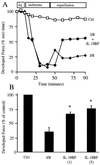Inhibition of caspase 1 reduces human myocardial ischemic dysfunction via inhibition of IL-18 and IL-1beta
- PMID: 11226333
- PMCID: PMC30232
- DOI: 10.1073/pnas.041611398
Inhibition of caspase 1 reduces human myocardial ischemic dysfunction via inhibition of IL-18 and IL-1beta
Abstract
The proinflammatory cytokine IL-18 was investigated for its role in human myocardial function. An ischemia/reperfusion (I/R) model of suprafused human atrial myocardium was used to assess myocardial contractile force. Addition of IL-18 binding protein (IL-18BP), the constitutive inhibitor of IL-18 activity, to the perifusate during and after I/R resulted in improved contractile function after I/R from 35% of control to 76% with IL-18BP. IL-18BP treatment also preserved intracellular tissue creatine kinase levels (by 420%). Steady-state mRNA levels for IL-18 were elevated after I/R, and the concentration of IL-18 in myocardial homogenates was increased (control, 5.8 pg/mg vs. I/R, 26 pg/mg; P < 0.01). Active IL-18 requires cleavage of its precursor form by the IL-1beta-converting enzyme (caspase 1); inhibition of caspase 1 also attenuated the depression in contractile force after I/R (from 35% of control to 75.8% in treated atrial muscle; P < 0.01). Because caspase 1 also cleaves the precursor IL-1beta, IL-1 receptor blockade was accomplished by using the IL-1 receptor antagonist. IL-1 receptor antagonist added to the perifusate also resulted in a reduction of ischemia-induced contractile dysfunction. These studies demonstrate that endogenous IL-18 and IL-1beta play a significant role in I/R-induced human myocardial injury and that inhibition of caspase 1 reduces the processing of endogenous precursors of IL-18 and IL-1beta and thereby prevents ischemia-induced myocardial dysfunction.
Figures







References
-
- Bolli R. Circulation. 1990;82:723–738. - PubMed
-
- Meldrum D R, Cleveland J C, Jr, Cain B S, Meng X, Harken A H. Ann Thorac Surg. 1998;65:439–443. - PubMed
-
- Gurevitch J, Frolkis I, Yuhas Y, Paz Y, Matsa M, Mohr R, Yakirevich V. J Am Coll Cardiol. 1996;28:247–252. - PubMed
-
- Cleveland J C J, Meldrum D R, Cain B S, Banerjee A, Harken A H. Circulation. 1997;96:29–32. - PubMed
Publication types
MeSH terms
Substances
Grants and funding
LinkOut - more resources
Full Text Sources
Other Literature Sources
Medical
Molecular Biology Databases
Miscellaneous

